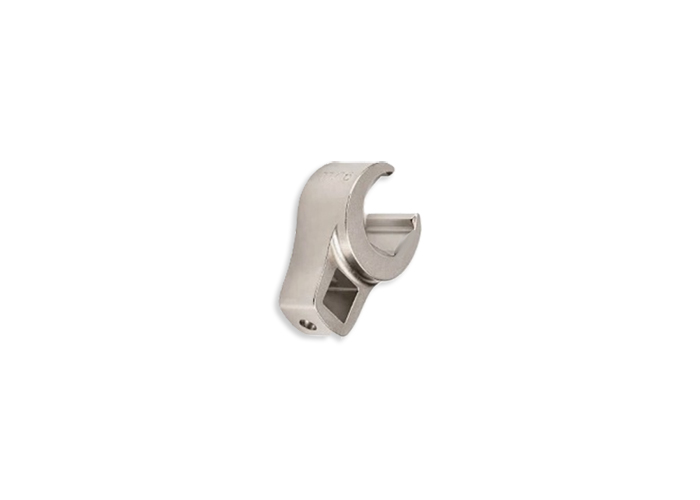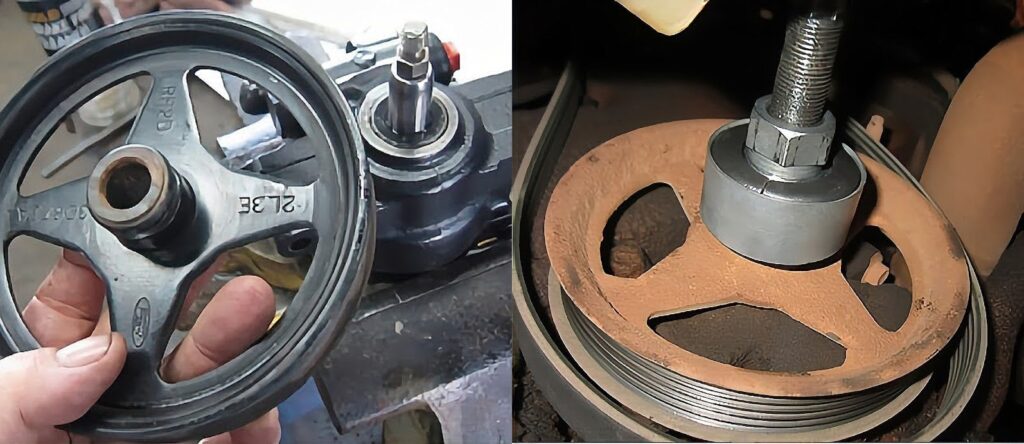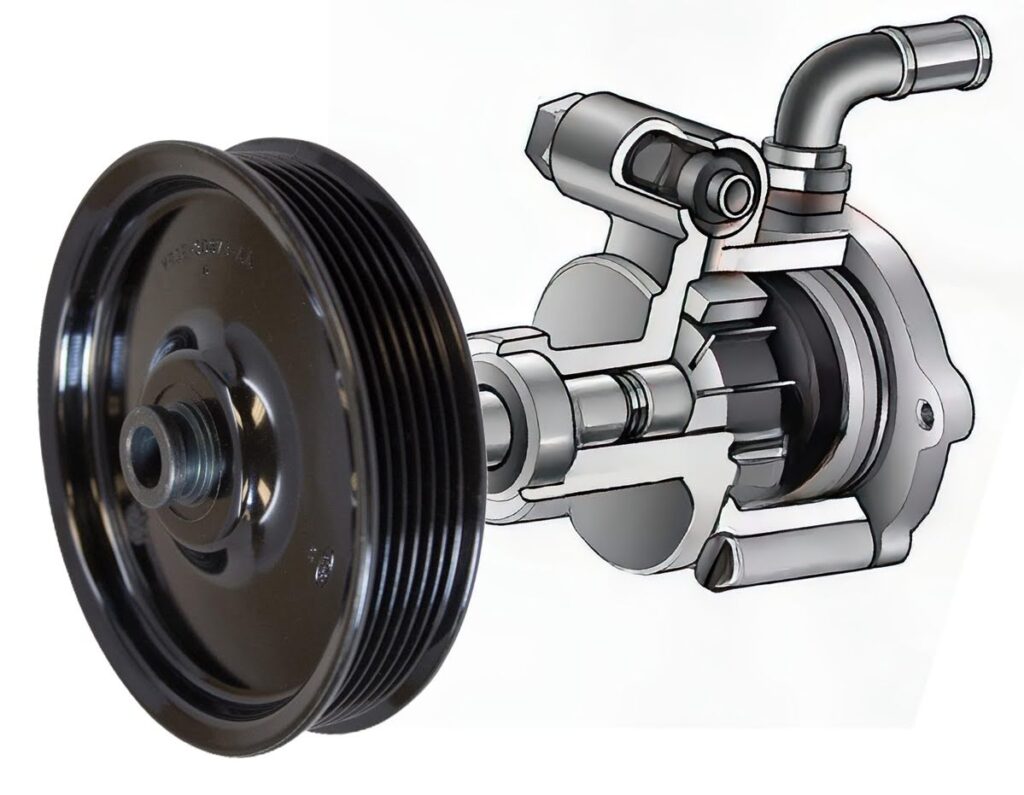Just because you can drive with a faulty power steering pump doesn’t mean you should. Power steering pump failure is a big red flag you should never ignore. It can make steering your vehicle hard, which puts you at greater risk of getting into an accident. As soon as you notice an issue with it, you should avoid driving until you replace your power steering pump.
Tips on How To Replace the Power Steering Pump
Power steering pump replacement can be an intimidating task, but it doesn’t have to be rocket science. Here are some tips to make things easier:
Identifying Power Steering Issues
Before you can replace your power steering pump, it’s best to be 100% sure that it’s actually the issue. Luckily, power steering pump failure is typically easy to spot. A loss of power assist, leaks from the power steering hoses, and cracks in the pump’s body all point to a faulty pump.
Power steering issues won’t always be that obvious, and some signs like unusual whining noises can point to other problems, too. Some belts will make whining noises, as will some other components and pulleys that may have bad bearings, so if you’re not feeling anything odd about the steering while turning, don’t replace the power steering pump before ruling everything else out first. If you’re not 100% sure, consider asking a mechanic for help.
Preparing the Necessary Tools
You’ll save yourself a lot of time by preparing everything you need before you start. Depending on the condition of your vehicle, you’ll likely need all or most of these tools:
- Replacement power steering pump
- Power steering fluid
- Power steering pulley remover and installer kit (always grease the threads)
- Power steering hose remover tool
- Socket wrench set
- Wrench set
- Torque wrench
- Drain pan
- Jack and jack stands

You’ll be dealing with a lot of power steering fluid, so be sure to wear comfortable clothes that you don’t mind getting dirty. Preparing a few towels can also make your clean-up a lot easier.
Taking Safety Precautions
You can never be too safe when repairing your vehicle by yourself. Before you replace the steering pump, consider letting the engine cool first.
Note, however, that power steering fluid won’t be hot enough to burn you unless extreme steering maneuvers have been done right before you opened the hood. Usually by the time you get the belt off, the fluid will be cool. It’s not under pressure like the coolant, so there isn’t much danger of getting burned by power steering fluid.
Using a Line Wrench
As much as possible, avoid using pliers or an open end wrench to remove the fittings from your steering pump. Both of these tools can damage the nuts and make it hard for you to apply the correct torque. Consider using a line wrench instead. It’s great for nuts made of soft metal, so you’re less likely to damage them in the process.

Replacing the Power Steering Hose

Before you pack up your toolbox, consider checking on your power steering hoses first. Try starting your engine and (with eye protection) watch while an assistant turns the steering wheel. If there’s a line leaking you’ll usually see fluid on the ground or in the engine compartment, but watching while an assistant turns the wheels will help you find the leak.


If there’s a line leaking you’ll usually see fluid on the ground or in the engine compartment, but watching while an assistant turns the wheels will help you find the leak.
– Richard McCuistian, ASE Certified Master Automobile Technician
Installing a Power Steering Filter
A power steering filter can help prevent premature failure, so you might want to consider installing one for your vehicle. You can find universal filters that’ll fit most vehicles, or you can check if your manufacturer offers one that’s specific to your vehicle.
Note, however, that a power steering filter is mostly for belt-and-suspenders DIY folks. Most vehicles won’t have any filter except the one in the bottom of the reservoir, which is a screen.
Replacing the Power Steering Pump
Depending on your vehicle’s year, make, and model, you might have to remove some parts first to access the pump. Of course, you’ll also need to remove the belt. On some vehicles, you can just dive right in and drain the power steering system. If you aren’t sure where to begin, consider asking a mechanic for advice.
Typically, the most challenging part of the job is removing and reinstalling the power steering pump pulley. Sometimes it must be removed before you can even unbolt the power steering pump. You can rent a special tool to remove and reinstall the pulley.

Some pulleys can be very difficult to remove, so be ready for this, too. You may encounter serious issues removing the pulley. Usually it comes off easily with the tool, but sometimes it’s very difficult.

Burping the Power Steering System
You might have to burp the power steering system to make sure you correctly replaced the pump. Burping the power steering system means making sure there’s no more air left after you drain the system. This typically involves slowly turning the steering wheel left and right until there’s no more air left in the system.
What Is a Power Steering Pump?

You can think of the power steering pump as the heart of your vehicle’s power steering system. There are several types of power steering pumps, such as the rotary vane, roller, and slipper. While they differ in design, they all serve the same function in helping the driver steer the vehicle.
How Does the Power Steering System Work?
The power steering pump has a large pulley because the torque applied to the pump is more important than the speed at which it is driven. It produces hydraulic pressure that is directed through a spool valve when you turn the wheel to help turn the wheels during steering maneuvers, particularly during slow driving when a lot of steering is necessary.
The fluid reservoir is either built onto the pump or mounted remotely. There is a flow control valve at the pump outlet. The pump produces up to 1500 psi when steering assist is required. There is a return line (low pressure) that carries the fluid back to the reservoir from the steering gear or rack.
Power Steering Pump Replacement Cost
The cost to replace your power steering pump varies depending on several factors, including your vehicle’s year, make, and model. For the most part, however, you can expect to spend anywhere from $40 to $1430 for the pump itself and around $300 for labor fees.
Get a Power Steering Pump That Fits Your Vehicle
No matter what anybody says, you should avoid driving your car until you fix your inoperable power steering pump. Without the help of your power steering pump, you’ll likely have a hard time steering your vehicle. Over time, a leak can also develop and damage other parts of the system. Thankfully, getting a brand-new power steering pump is fast and easy with CarParts.com.
CarParts.com offers a wide selection of high-quality power steering pumps, sourced from only the most trusted manufacturers in the industry. If you’re on a budget, you’ll be pleased to find pumps available at different price points. Easily browse through all available parts by filtering them according to your preferred price.
Don’t wait until your faulty power steering pump interferes with your steering before replacing it. Check out our selection of high-quality power steering pumps at CarParts.com and get one for your vehicle today!
Any information provided on this Website is for informational purposes only and is not intended to replace consultation with a professional mechanic. The accuracy and timeliness of the information may change from the time of publication.






























